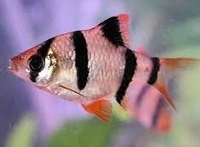

Product Details

Size
1cm - 3cm

Temperament
Peaceful
The Tiger Barb, scientifically known as Puntigrus tetrazona, is a captivating and active freshwater fish that adds a splash of energy and striking patterns to any aquarium. With its distinctive tiger-like stripes and playful behavior, the Tiger Barb is a popular choice among aquarists who seek small schooling fish for their community tanks. Originating from Southeast Asia, particularly Indonesia and Borneo, these barbs are known for their active nature and schooling behavior, making them an excellent choice for aquarium enthusiasts of all experience levels. Let's explore a detailed description of these remarkable fish, including essential information on their appearance, water conditions, tank setup, feeding habits, and care.
Appearance:
- Striking Tiger-Like Stripes: The Tiger Barb gets its name from its vibrant black vertical stripes that resemble the pattern of a tiger, contrasting against a gold to orange body color.
- Size: They are small fish, reaching an adult length of around 2 to 3 inches (5 to 7.5 centimeters).
Water Conditions:
- Temperature: Maintain a tropical water temperature range of 72°F to 82°F (22°C to 28°C) to ensure the well-being of Tiger Barbs.
- pH Level: Aim for a slightly acidic to neutral pH level between 6.0 and 7.5 to replicate their natural habitat.
- Water Hardness: Provide a moderately hard water with a hardness level between 5 and 15 dGH.
- Filtration: Efficient filtration and regular water changes are essential to maintain excellent water quality.
Tank Setup:
- Tank Size: Tiger Barbs can be kept in a small to medium-sized tank of at least 20 gallons (75 liters) due to their schooling nature and active swimming behavior.
- Aquascape: Create a well-decorated environment with live plants, smooth rocks or driftwood, and open swimming areas to mimic their natural habitat and allow them to showcase their schooling behavior.
- Schooling Fish: They are social fish and should be kept in a group of at least six individuals to feel secure and exhibit their natural schooling behavior.
- Peaceful Tank Mates: Although somewhat nippy, they can coexist with other semi-aggressive community fish species.
Feeding Habit:
- Omnivorous Diet: Tiger Barbs are omnivores and accept a wide variety of foods.
- High-Quality Flakes and Pellets: Offer high-quality flakes or pellets suitable for small tropical fish as their primary diet.
- Supplementary Foods: Provide occasional treats of live or frozen foods such as brine shrimp, daphnia, or bloodworms to supplement their diet.
Care:
- Active Nature: Tiger Barbs are energetic and active swimmers, so ensure they have plenty of swimming space in the aquarium.
- Schooling Behavior: Keeping them in a group encourages their natural schooling behavior and reduces stress.
- Observation: Monitor their behavior and appearance to ensure they are healthy and showing no signs of stress or illness.
Tiger Barb
Product Options
Regular
Delivery
Quantity
 FishList by DesmondLim Teck Whye
FishList by DesmondLim Teck Whye Aquarium Fishes, Tanks & Supplies From FishList by DesmondLim Teck Whye


 SG
SG



